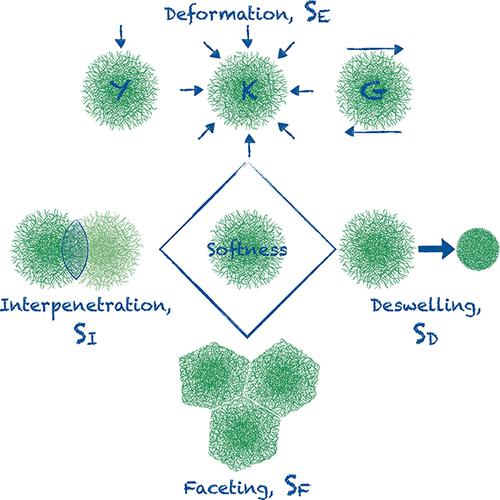当前位置:
X-MOL 学术
›
Chem. Rev.
›
论文详情
Our official English website, www.x-mol.net, welcomes your feedback! (Note: you will need to create a separate account there.)
How Softness Matters in Soft Nanogels and Nanogel Assemblies
Chemical Reviews ( IF 62.1 ) Pub Date : 2022-06-07 , DOI: 10.1021/acs.chemrev.2c00035 Andrea Scotti 1 , M Friederike Schulte 1 , Carlos G Lopez 1 , Jérôme J Crassous 1 , Steffen Bochenek 1 , Walter Richtering 1
Chemical Reviews ( IF 62.1 ) Pub Date : 2022-06-07 , DOI: 10.1021/acs.chemrev.2c00035 Andrea Scotti 1 , M Friederike Schulte 1 , Carlos G Lopez 1 , Jérôme J Crassous 1 , Steffen Bochenek 1 , Walter Richtering 1
Affiliation

|
Softness plays a key role in determining the macroscopic properties of colloidal systems, from synthetic nanogels to biological macromolecules, from viruses to star polymers. However, we are missing a way to quantify what the term “softness” means in nanoscience. Having quantitative parameters is fundamental to compare different systems and understand what the consequences of softness on the macroscopic properties are. Here, we propose different quantities that can be measured using scattering methods and microscopy experiments. On the basis of these quantities, we review the recent literature on micro- and nanogels, i.e. cross-linked polymer networks swollen in water, a widely used model system for soft colloids. Applying our criteria, we address the question what makes a nanomaterial soft? We discuss and introduce general criteria to quantify the different definitions of softness for an individual compressible colloid. This is done in terms of the energetic cost associated with the deformation and the capability of the colloid to isotropically deswell. Then, concentrated solutions of soft colloids are considered. New definitions of softness and new parameters, which depend on the particle-to-particle interactions, are introduced in terms of faceting and interpenetration. The influence of the different synthetic routes on the softness of nanogels is discussed. Concentrated solutions of nanogels are considered and we review the recent results in the literature concerning the phase behavior and flow properties of nanogels both in three and two dimensions, in the light of the different parameters we defined. The aim of this review is to look at the results on micro- and nanogels in a more quantitative way that allow us to explain the reported properties in terms of differences in colloidal softness. Furthermore, this review can give researchers dealing with soft colloids quantitative methods to define unambiguously which softness matters in their compound.
中文翻译:

柔软性在软纳米凝胶和纳米凝胶组件中的重要性
从合成纳米凝胶到生物大分子,从病毒到星形聚合物,柔软性在决定胶体系统的宏观性质方面起着关键作用。然而,我们缺少一种量化纳米科学中“柔软度”一词含义的方法。拥有定量参数是比较不同系统和了解柔软度对宏观特性的影响的基础。在这里,我们提出了可以使用散射方法和显微镜实验测量的不同数量。在这些数量的基础上,我们回顾了最近关于微凝胶和纳米凝胶的文献,即在水中膨胀的交联聚合物网络,这是一种广泛使用的软胶体模型系统。应用我们的标准,我们解决的问题是什么使纳米材料柔软?我们讨论并介绍了量化单个可压缩胶体柔软度的不同定义的一般标准。这是根据与变形相关的能量成本和胶体各向同性去溶胀的能力来完成的。然后,考虑软胶体的浓缩溶液。在刻面和互穿方面引入了取决于粒子间相互作用的柔软度的新定义和新参数。讨论了不同合成路线对纳米凝胶柔软度的影响。考虑了纳米凝胶的浓缩溶液,我们回顾了文献中关于纳米凝胶在三维和二维的相行为和流动特性的最新结果,根据我们定义的不同参数。本综述的目的是以更定量的方式查看微凝胶和纳米凝胶的结果,从而使我们能够根据胶体柔软度的差异来解释报告的特性。此外,这篇综述可以为研究软胶体定量方法的研究人员提供明确定义其化合物中哪些柔软度很重要的方法。
更新日期:2022-06-07
中文翻译:

柔软性在软纳米凝胶和纳米凝胶组件中的重要性
从合成纳米凝胶到生物大分子,从病毒到星形聚合物,柔软性在决定胶体系统的宏观性质方面起着关键作用。然而,我们缺少一种量化纳米科学中“柔软度”一词含义的方法。拥有定量参数是比较不同系统和了解柔软度对宏观特性的影响的基础。在这里,我们提出了可以使用散射方法和显微镜实验测量的不同数量。在这些数量的基础上,我们回顾了最近关于微凝胶和纳米凝胶的文献,即在水中膨胀的交联聚合物网络,这是一种广泛使用的软胶体模型系统。应用我们的标准,我们解决的问题是什么使纳米材料柔软?我们讨论并介绍了量化单个可压缩胶体柔软度的不同定义的一般标准。这是根据与变形相关的能量成本和胶体各向同性去溶胀的能力来完成的。然后,考虑软胶体的浓缩溶液。在刻面和互穿方面引入了取决于粒子间相互作用的柔软度的新定义和新参数。讨论了不同合成路线对纳米凝胶柔软度的影响。考虑了纳米凝胶的浓缩溶液,我们回顾了文献中关于纳米凝胶在三维和二维的相行为和流动特性的最新结果,根据我们定义的不同参数。本综述的目的是以更定量的方式查看微凝胶和纳米凝胶的结果,从而使我们能够根据胶体柔软度的差异来解释报告的特性。此外,这篇综述可以为研究软胶体定量方法的研究人员提供明确定义其化合物中哪些柔软度很重要的方法。


























 京公网安备 11010802027423号
京公网安备 11010802027423号